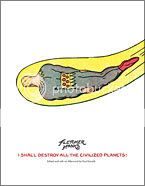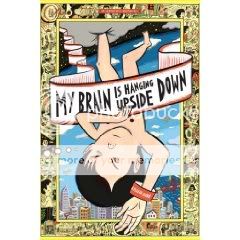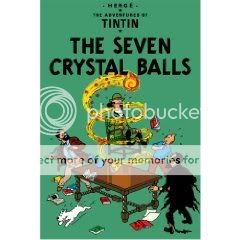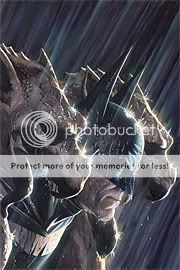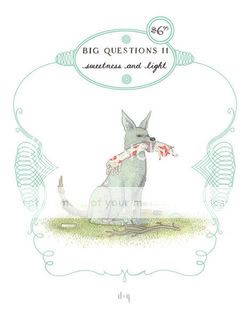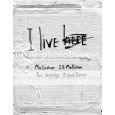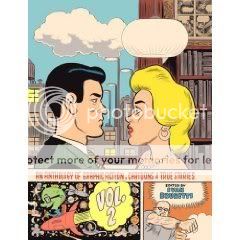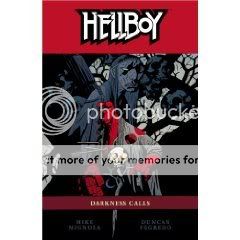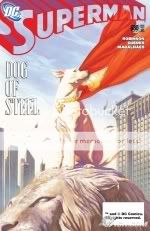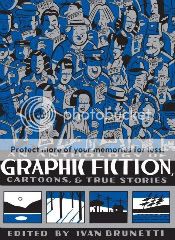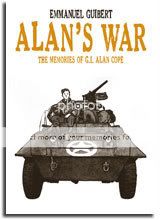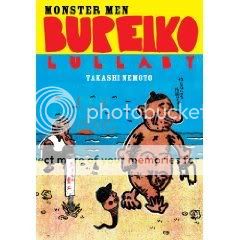Posts Tagged ‘comics reviews’
Comics Time: I Shall Destroy All the Civlized Planets
December 15, 2008I Shall Destroy All the Civilized Planets!
Fletcher Hanks, writer/artist
Paul Karasik, editor, afterword writer/artist
Fantagraphics, 2007
124 pages
$19.95
Okay, so obviously the thing that strikes you initially is that these stories are completely insane. They treat the basic structure of superhero comics–“villain commits crime, hero captures villain,” as Karasik’s mother puts it in the afterword–like the bare necessities for a spirited game of Calvinball–all you need is Calvin, Hobbes, and a ball, and the rest is up to your imagination. And Fletcher Hanks’s imagination was twisted beyond description. It’s not just that the demises his godlike heroes Stardust and Fantomah cook up for their villainous prey are brutal, it’s that they’re needlessly baroque. So Stardust doesn’t just feed a racketeer to a giant golden octopus–He wraps up the bad guy in his giant flexible hand, whisks him away to a desert island that he first overwhelms with a tidal wave, then lifts up into the air, drops the guy onto, flips over, and puts back down, after which the guy is flushed through an underground lagoon onto the shore, and then and only then does the golden octopus eat him. Similarly, Fantomah doesn’t just toss a ring of diamond thieves to a pit of cobras–she whisks them away to the jungle pit of death, where she fuses them into one person, who is terrified by the creatures of an unfound world, flees up a mountain only to find a dead end, gets scared off the cliff by a giant floating paw, and gets caught by a whirlwind that blows him into a cave filled with giant albino cobras who kill him, after which Fantomah floats his body out into midair, where the unfound world creatures summon another disembodied hand from the cliff surface to grab it and drag it back into the cliff, where it presumably remains to this day. The picture of Hanks as a naive dispense of two-fisted justice doesn’t do justice to these comics at all. They have a stream of consciousness feel to them that makes Final Crisis seem straightforward and restrained. They’re more than just goofy and violent and mean, though they’re certainly all of those things–they’re unrestrained, unhinged.
But even more than that, they’re things of great beauty! I can’t stress that enough. Hanks may have been a lot of things, but he truly was a wonderful visual stylist. A favorite tactic involves suspending his various thugs, heroes, corpses, jungle creatures, weapons of mass destruction etc. in mid-air, an effect that is dynamic and still at the same time, suggestive of great power and great restraint simultaneously. There’s a lovely panel of multicolored planes dropping matching bombs, another of a red sky filled with the floating silhouettes of giant panthers. Indeed, any time Hanks gets to draw a lot of the same thing at once is a good time to be a comics reader. That aforementioned albino cobra pit, an army of giant disembodied flaming pink claws–they’re almost always beautifully arranged within their panels and dazzling in their multiplicity, a signature effect as recognizable as Kirby krackle or Ditko hands. Hanks wasn’t a perfect cartoonist by any stretch–anatomy, obviously, was not his strong suit, and it’s those goofy underbites and mircrocephalic heads that give him his Ed Wood rep–but what he did well, he really did well.
Comics Time: Maggots
December 12, 2008Maggots
Brian Chippendale, writer/artist
PictureBox, 2007
344 pages
$21.95
Buy it from PictureBox, pretty cheap in fact
Here’s a hard one to wrap your head around. Maggots is a book that almost prides itself on its insular incomprehensibility. Originally and infamously drawn over the pages of a Japanese book catalog, its panels are meant to be read in a chutes-and-ladders zig-zag that skips, stutters, and shifts direction entirely the second you finally feel like you have a handle on it. In a sense, the first effect you get from reading the book is to learn how to read it. Slowly, your eyes become better at detecting characters’ changes in direction, their movements up or down, how they sit down or stand up or lie down, how they eat or fuck or simply walk up to one another. Eventually these clues enable you to read enough panels in the proper order–or at the very least get some kind of overall sense of what’s happening on a page–so that you can understand what’s going on.
So what’s going on? Well, that’d be kind of difficult to grok even if the book weren’t constructed like a clue someone found in the Orchid Station on Lost. Basically, a bunch of little munchkiny guys run around (literally, a lot of the time) behaving in ways that frequently lead to violent confrontation, whether that involves giants, or rabbits with samurai swords, or people stealing each other’s eyeballs, or the victims of eyeball theft coming back to exact their revenge. The “story” isn’t so much a plot as it is a sense of ever-present danger, the idea that the cute li’l business we’re seeing involving eating raisins and sticking the container somewhere hard for someone else to get to afterwards could at any moment give way to a legion of attacking mice, or some sort of death-mask-wearing sorcerer, or some genuinely unpleasant knifework.
The tension is maintained by Chippendale’s art, which feels like a peak into a hermetically sealed limbo of endless black, occasionally interrupted by secret trapdoors, ladders, and at least one food stand. Panels are tiny, cramped, filled in as much as they can be, careening wildly from one end of the page to the other. Even the white space is busy, showing the text of the catalog underneath. No matter how much our hero Hot Potato and his comrades and enemies run, jump, climb, crawl, and even fly, there doesn’t seem to be any way out for them. Of course, this makes the moments when Chippendale pulls back for a dazzling spread–a field of flowers, the arrival of that sorcerer guy, a massive staircase–all the more impressive. That’s the oldest trick in the book, but there’s a reason for that: It works.
And so, in its weird way, does Maggots. This isn’t going to be launching a Teenage Mutant Ninja Turtle-style wave of imitators anytime soon, even among the most Fort Thunder influenced cats around today–a 344-page experiment in graphic novel form? It’s a miracle this thing ever got published. And it’s certainly a challenging, at times frustrating read, with not a whole lot in terms of immediate satisfaction going for it. But once you get into that groove of letting your eyes weave back and forth across the pages, you just start appreciating the aesthetic qualities of the thing. Those chunky black panels. Chippendale’s Muybridge-like proficiency with breaking physical action down into its constituent beats. The character designs. The humor (“We have a no pants, no service policy.” “Do you have pants back there? I’ll take them.” “Sorry–no pants, no service”). The genuine, if raw, eroticism of all those bizarre sex scenes (I actually think this strange, avant garde comic captures the awkwardness and explosiveness of long-distance relationship reunions as well as any I’ve read). The random, astutely observed moments of quotidian business (there’s a great, two or three panel bit where Hot Potato scoops up a cat who was crawling around the sink that brought a smile of familiarity to my face). Even the sumptuous texture of the cover underneath the dust jacket. This is not a comic for everyone, duh, but if you’ve been interested in it in the past, I think you’ll find it interesting.
Comics Time: Real Stuff
December 10, 2008Real Stuff
Dennis P. Eichhorn, writer
∆, Rick Altergott, Peter Bagge, Jim Blanchard, Ariel Bordeaux, Rupert Bottenberg, Chester Brown, Ivan Brunetti, Charles Burns, Howard Chackowicz, David Chelsea, Dan Clowes, David Collier, Dave Cooper, Robert L. Crabb, Lloyd Dangle, Julie Doucet, Michael Dougan, Gary Dumm, B.N. Duncan, Gene Fama, Mary Fleener, Drew Friedman, Renée French, Roberta Gregory, Sam Henderson, Gilbert Hernandez, Jaime Hernandez, Sean M. Hurley, Gerald Jablonski, Peter Kuper, Carol Lay, Jason Lutes, Kent Myers, Bernard Edward Mireault, Carel Moiseiwitsch, Terry Moore, Pat Moriarity, Joe Sacco, Seth, Leslie Sternbergh, Carol Swain, Holly Tuttle, Colin Upton, J.R. Williams, Jim Woodring, Joe Zabel, Mark Zingarelli, artists
Swifty Morales Press, 2004
208 pages
$19.95
Buy it used, and cheap, from Amazon.com
How is Denny Eichhorn not a major cult figure? I’m honestly curious, and maybe some of my older readers can fill me in, since obviously he was a big deal in ’90s altcomix culture. But I can’t remember ever discussing him or his work with any of my friends or peers; the few times I’ve brought him up in the context of being one of three writers who’s made a go of creating alternative comics without drawing them himself, alongside Alan Moore and Harvey Pekar, I’ve gotten funny looks. Heck, I didn’t even really know what I was talking about, not until I read this collection. And shit the bed, I sort of feel like I need to physically pass it around to all of my friends until they’re all on my wavelength. To quote The Big Lebowski, “I won’t say ‘a hero,’ ’cause what’s a hero?”–but Denny Eichhorn is a goddamn inspiration.
I think the great trick of this collection of some of Eichhorn’s sex/drugs/violence-soaked autobio strips–drawn by the above host of collaborators, all of whom seem perfectly at home with their material, which is really a testament to them and Eichhorn both–is editor and publisher Caleb Wright’s chronological arrangement of them. That way, we get to know Eichhorn as a child first, and by the time his most outré misadventures head our way, it’s too late to detach ourselves from him. So sure, it’s funny to watch Peter Bagge draw Eichhorn getting so freaked out by his first Mad magazine he pukes, or Pat Moriarty showing a mix-up at a pharmacy that leads to young Denny being sold a pack of condoms for a science project, or early-vintage Dave Cooper (already a dazzlingly slick illustrator) presenting the story of how the cops broke the crazy next-door neighbor’s dick free of the glass bottle it was struck in. (There will be blood.) Even in the first serious bouts of violence we see, teen- and college-age Eichhorn is in the right; when a double-page Joe Zabel/Gary Dumm spread shows us exactly what happens when Eichhorn smashes a glass bottle into the face of his attacker, or J.R. Williams shows the toe of Eichhorn’s boot literally splattered with the remains of his assailant’s eyeball, you almost can’t help but cheer even as you recoil, laugh with triumph even as you shake your head with disbelief. It’s like the autobiographical comics equivalent of the climax of Rambo.
So when you finally start seeing hints of how Eichhorn’s tendency toward illicit behavior can bring out the worst in other people, and vice versa, it becomes a lot harder to write him off. Yes, there’s a way of looking at things where tipping off the part-time prostitute who’s hosted a week-long gangbang of the entire freshman class of Eichhorn’s university that the cops were on to her was the right thing to do–but this more or less ensured a continued life of abusive neglect for the baby she plies with cola and calls “Shithead” when she’s not fingercuffing the football team. There’s no reason to believe that the string of sex workers with whom Eichhorn has off-the-books dalliances are anything but the carefree lust-for-life types they (and Eichhorn!) appear to be–until one turns out to be the accomplice of a pair of serial sex murderers (and a serial killer in her own right), and another sticks a gun in her mouth and pulls the trigger mere hours after sticking Denny’s cock in her mouth and pulling his. That last strip may contain the most memorable cartooning in the entire anthology, which is really saying something amid the Saccos and Colliers and Chelseas and Woodrings and Doucets: Carel Moiseiwitsch’s deep blacks and deranged linework evoke Rory Hayes as the soon-to-be-suicidal woman literally attacks Eichhorn’s genitals, and caps things off with the post-orgasmic entreaty “REMEMBER ME!”–no narrative caption set-up, no establishing shots, just the woman’s demonic face.
This is not to say that it’s all eye-gouging and self-destruction. A lot of Eichhorn’s doping, drinking, and fucking are perfectly delightful for everyone involved, and a lot more are embarrassing but hella funny in hindsight. You’ve gotta love a book that includes a story about a dominatrix that ends with the sentence “Then it hit me: I shoulda pissed on his head!” and whose genuine, if off-kilter, father-son bonding strip involves giving your dad weed. It’s the gestalt of the thing that makes it so memorable, and enough to put you off comics about the awkward night Brooklyn Hipster had that one time forever. It fits right in with Boy’s Club, the Manly Movie Mamajamas, and other vicarious portraits of the less savory side of masculinity pushed to its illogical conclusion. If I could get 20 copies of this I’d give them away as stocking stuffers.
Comics Time: Kramers Ergot 6
December 8, 2008Kramers Ergot 6
Sammy Harkham, editor
Alvin Buenaventura, assistant editor
Carlos Gonzales, Shary Boyle, Matthew Thurber, Jason T. Miles, Andrew J. Wright, Sammy Harkham, Fabio Viscogliosi, C.F., Dan Zettwoch, Mark Smeets, Marc Bell, Bald Eagles, Chris C. Cilla, Martin Cendreda, Paper Rad, Jerry Moriarty, Gary Panter, Suihô Tagawa, Vanessa Davis, Souther Salazar, James McShane, Shary Boyle, Jeff Ladouceur, Ron Regé Jr., Elvis Studio (Helge Reumann & Xavier Robel), Tom Gauld, John Porcellino, writers/artists
Chris Ware, Tim Hensley, Paul Karasik, contributors
Buenaventura Press/Avodah Books, 2006
336 pages
$34.95
Can I just say how much I love how this volume of Sammy Harkham’s landmark anthology series opens? Credits pages in big, no-nonsense, all-caps letters alternate with splash page pin-ups and blown-up panels from the strips to come. It’s like the book has an opening credit sequence. I coincidentally paged through it at the same time as listening to “Speed of Life,” the opening track on David Bowie’s album Low, and it was as delightful a comics-reading experience as I’ve had all year.
That said, this may be the least immediately impactful post-volume-four Kramers. In some ways that’s to be expected: The previous volumes, particularly 4, were so groundbreaking that at a certain point you kind of just have to stand there and say “wow, we’re standing on the ground we broke a while ago, how about that?” As a matter of fact, I think this is the farthest-out volume, least “alt,” most “art/underground” collection of the three–there’s a degree to which it takes for granted that you’re willing to slug it out there on the borderland between comics and fine art and tugs you deep into the realm of the non-narrative and non sequitur.
For the most part, that’s a fine decision. There’s rough stuff to ponder from Bald Eagles, whose self-pitying, society excoriating autobio strip is transformed into something of a sci-fi fantasia by art so maniacally detailed it makes Geof Darrow look like John Porcellino, and from Chris Cilla, who serves up a sordid, coprophilia-tinged story of undercover cops gone very very bad. There’s stunning color work to be found in the rainbow psychedelia of Shary Boyle’s series of disturbingly sexualized 18th-century illustration riffs, in the green-on-pink shimmerings of Matthew Thurber’s goofball saga of a high school overtaken by a Mayan human-sacrifice cult, and in the lush pastels of World War II-era manga-ka Suihô Tagawa’s deceptively adorable funny-animal war propaganda. There’s the de rigeur contribution from the reliably hilarious Paper Rad, a literal interpretation of “Kramer’s Ergot” that made this Seinfeld fan laugh out loud. Competing takes on minimalism–C.F.’s explosively dynamic sci-fantasy and John Porcellino’s suburban haiku–bookend the collection. This is all exciting work, bursting with visual vitality and a certain distaste for the rules. It’s mostly loud and it’ll get you funny looks when you read it on the train (trust me), but it’s also very intelligent, rarely if ever shock for shock’s sake.
However, I do feel like there’s a higher quotient of work here that doesn’t quite, uh, work. I’ve seen enough of the oft-anthologized donkey strips of Fabio Viscogliosi and Fervler & Razzle strips of Souther Salazar to last me for quite some time. Bald Eagles and Jason T. Miles aside, most of the autobio work here–from James McShane, Vanessa Davis, and Ron Regé Jr.–works any better here than it does in the other anthologies you might have seen it in lately. Marc Bell’s stream-of-consciousness illustration/text combos just make me wish he was making more of his hysterically funny, rewardingly weird comic strips instead. I think the formal strength of Gary Panter’s Dal Tokyo strips reprinted here is diluted somewhat by being surrounded by so much similar material, so much illogic’n’markmaking. On the flipside, the more straightforward strips–Tom Gauld’s latest “two lonely coworkers in a weird environment” strip, Harkham’s tale of discontent in the shtetl, an emo little thing from Martin Cendreda, another story of mild hijinks in a midwestern church that occasionally uses diagrams from Dan Zettwoch–feel drowned out by the visual cacophony of your Bells and Elvis Studios and the monumental fine-art splash pages of your Boyles and Jerry Moriartys.
But I tend to be quite forgiving to anthologies that serve up a selection of inconsistent but thrilling-at-its-best work, and in that sense Kramers Ergot 6 is no exception. Indeed, the entire Kramers project seems to me to be one of juxtaposition, a when-worlds-collide affair. Not all those worlds are going to be equally interesting, but that’s fine when the ones that are are so rich and rewarding of your comics-thinking time and attention.
Comics Time: My Brain Is Hanging Upside Down
December 5, 2008My Brain Is Hanging Upside Down
David Heatley, writer/artist
Pantheon, September 2008
128 pages, hardcover
$24.95
The prospect of reviewing these intensely autobiographical comics by David Heatley is a daunting one because there seems to be no way to do so without reviewing David Heatley. Oddly, I’ve never really felt that way about his work before when I’ve encountered it. I thought his surreal “Overpeck” serial in MOME was powerful–as good as his dream comics might have been had he not labeled them “dream comics” and thus neutered their disquieting illogic. I’m also on the record as a great admirer of his “Sex History” strip as it appeared in Kramers Ergot 5 (the 48-panel grids were a brilliant way to convey such an overwhelming amount of uncomfortable information), and a defender of the “Portrait of My Mom” and “Portrait of My Dad” strips that appeared in Ivan Brunetti’s second Anthology of Graphic Fiction (they displayed Heatley’s underappreciated sense of humor and comedic build-up within each sub-strip). In none of these cases did I feel like I was evaluating Heatley as a person.
But My Brain put me in that uncomfortable position, perhaps–almost certainly, in fact–because my reaction to it was so viscerally negative. There are plenty of comics I’ve read that left me thinking “that should have been done differently”; this is the first I’ve read in a long time that made me think “this shouldn’t have been done at all” (and wasn’t written by Jeph Loeb). The primary culprit? “Race History,” a black-and-white (no pun intended) companion piece to “Sex History,” detailing Heatley’s relationships, however slight, with various black people he’s known. I’m trying to think of how to put this…there’s probably a way to take this idea and not make it just as dehumanizing and racist as it seems it would be, just as dehumanizing and racist as the behavior and mentality one assumes it’s designed to expose and excoriate, but boy howdy did Heatley not find that way! There’s something almost literally nauseating in this interminable onslaught of alternating bigotry and white liberal guilt. The point where my disgust for the strip became insurmountable was a scene where young David is sleeping over at a friend’s house, and the kid’s mother helps take care of David’s stomachache. “Try laying on yo belly. It should settle yo stomach down,” she says, in dialect reminiscent of late-’70s Marvel Comics street toughs, before David thinks “I forgot she’s a doctor.” And blam! It struck me how disgraceful it is to take this human being, who has a family, who worked the crazy hours and racked up the crazy student loans and god knows what else that all doctors do, reduced to a “blackcent”-spouting cameo in some guy’s ungodly long (seriously, at one point I closed the book and saw how many more black-trimmed pages of the strip I had left and my draw literally dropped) narcissistic display of how he’s spent his entire life looking at black people as being black before people.
I think the grossest thing about the strip, the part that prevents me from saying “well, he’s just cataloguing his own faults, he’s aware of how awful this is” is that even when his relationships with black people are healthy, mutually enjoyable ones, Heatley still seems to view them as trophies to prove his enlightenment. Every positive interaction with a stranger, every move to a black neighborhood that goes well, every friendship, every professor who helped him–it’s all the same as when he joined the Free Mumia movement, or the truly insufferable album (and sometimes movie/tv) reviews peppered throughout the strip where he proves how able he is to appreciate African-American culture. His review of the series The Wire has got to be the ne plus ultra of the genre:
One of the greatest works of art I’ve experienced in any medium. It unfolds with the kind of masterful pacing, sense of truth, reality, and tragic inevitability usually found in Tolstoy or Dostoevsky. It’s certainly the only TV show to alter my race conscious. I notice certain young black men who would have been invisible to me before, hidden behind the screen of my own ignorance and fear. I’d like to think I know something of their stories now. Awareness and compassion by themselves don’t change the world, but they’re a start. Speaking of which, did you know it’s Barack Obama’s favorite show, too?
This right next to a strip where he reacts to some jerky lady on the subway smacking him with her purse by coming home and beating a chair with his umbrella while shouting “YOU FUCKING NIGGER BITCH!” This incident just happened, too!
What I’m trying to say is that Heatley has loads more work to do on himself before he’s able to tackle this subject with anything remotely approaching insight or a worthwhile perspective. By contrast, when the original “Sex History” strip ends, you think to yourself, “Well, he’s aware that he’s behaved pretty ridiculously, and he’s trying much harder to be better about it.” Meanwhile, it’s not a “Woman History” strip where every female human he’s ever met is reduced to their primary and secondary sex characteristics, but a strip about his sex life–that’s a naturally proscriptive framework that I don’t think says anything untoward about how he views the people with whom he was sexually involved, male or female. You might have specific problems with how the focus is almost always on his pleasure rather than theirs, but that aside, the way he depicts sex–a combination of embarrassment, fun, awkwardness, beauty, predation, squalor, pleasure, depression, eroticism–maps pretty neatly to the way I imagine most of us have experienced it over the course of our lives. But “Race History”…I’m sorry, but if the word “nigger” occurs to you in anger, maybe it’s not your place to talk about which members of the Wu-Tang Clan had the best solo records?
This sort of retrospective inability to see that personal flaws require more than mere acknowledgment to be overcome gradually starts to bleed out into the other strips I once reacted more favorably to. The version of “Sex History” that appears here has been famously self-censored, placing neon pink bars across any images of penetration or ejaculation, and most erect penises in general. (It’s sort of like Greedo shooting first, only here, no one shoots at all.) A one-page epilogue added to the strip seems to reveal the rationale: Heatley has decided that his use of pornography qualifies as sex addiction, and through the help of a 12-step program he no longer uses porn or masturbates. Presumably, he’s neutering the strip to bring it in line with his newfound enlightenment. Now, this defeats the purpose of the strip, which is to be “apocalyptically revealing” as I once put it, and it’s sexist and hypocritical in an MPAA way, since you still see plenty of bush and titties. But worst of all, the 12-step higher-power imagery that pops up here and elsewhere–in the “Self-Portrait” strips that decorate the covers, the end of “Race History,” and the birth of Heatley’s second child in “Family History”–lends the whole affair a scent of sanctimony. Heatley has opened his life to God, God is literally cradling him in the palm of his hand, and however racist and sexually messed-up he may be, everything’s okay. But everything’s not okay! The first step is admitting you have a problem, but that’s only the first step! I know, I know, you can argue that Heatley is aware of all of this, that every moment of oblivious self-contradiction or narcissism or bigotry is committed to paper with full knowledge of exactly what it means. That’s fine, that’s fair, that’s probably actually true. That’s good enough for David Heatley the person, but it’s not good enough for David Heatley the artist. I need more.
Comics Time: Against Pain
December 3, 2008Against Pain
Ron Regé, Jr., writer/artist
Drawn and Quarterly, July 2008
128 pages, hardcover
$24.95
When it comes to art, I like to be able to get everything in one place. I don’t like it when bands leave the single off the album, and I want comic collections to contain every relevant strip they can. Yet I closed Against Pain, a collection of Ron Regé Jr.’s anthology contributions and one-off comics, wishing that it was shorter and contained less stuff. Regé is a cartoonist whose work I really treasure–I consider his Skibber Bee Bye one of my formative comics reading experiences and truly one of the best books of the decade, even now–but his oeuvre has at least as many misses as hits. That uniform line weight conveys the sense that everything is equally important, which is a core component of Regé’s philosophical project in most of his mature comics; the misses tend to be instances when this psychedelic, pantheistic take on both art and life comes across as mush rather than mind-expansion. Against Pain‘s flaw is that its editorial approach is similarly egalitarian, and similarly problematic.
In my experience, Regé is at his best when being his most ambitious. For example, Skibber feels like a freaking comet colliding with your brain, so big and sprawling and heavy is it compared to the rest of Regé’s usually much shorter works. Against Pain collects several, uh, let’s call them “suites” of comics that, though shorter, display genuine thematic fence-swinging. “We Must Know, We Will Know” (great title!), recently included by Ivan Brunetti in his second Yale University Press Anthology, is a series of candy-colored, interconnected strips about, of all things, math–how the unsolvable is solved, how models of certainty give comfort and how uncertainty gives freedom. A suite of “Pain” comics, I think created with funding from Tylenol (!), mines similar territory involving the mind’s hold on how we interact with the physical world, our own bodies included. There’s a lengthy Spider-Man parody called “High School Analogy” that works quite well as just that, but also reminds us how much fun the Spidey character can be when he really is a sullen teenage dirtbag and not a babe magnet. “She Sometimes Switched to Fluent English and Occasionally Used a Few Words of Hebrew,” the minicomic about a failed, female Palestinian suicide bomber that was included in Chris Ware’s McSweeney’s #13, contains perhaps the most direct articulation of Regé’s governing philosophy in the entire book: “All of our human lives are equally valuable*,” he says, before adding the footnote “or equally worthless…take your pick” as a seeming acknowledgment of the horrendous tit-for-tat brutality of this true story. It also presents a startling insight into the culture of young suicide “martyrs”: What if you lived in a place where low-level warfare could turn everyday teen angst into tragedy at a moment’s notice, and if there were organizations that thrived by transmogrifying that angst into violence? As a counterpoint, almost, there’s Regé’s legendary collaboration with his friend Joan Reidy, “Boys,” a series of simple nine-panel sex comics that are at turns lovely, funny, disturbing, sad, angry, and hot, which I induce from experience is likely many readers’ history with sex in a nutshell.
But there’s a lot of other stuff in here, and most of it isn’t nearly as successful. Perhaps counterintuitively given the rubric I just spelled out, one of the more frustrating strips is also one of the longest: “Fuc 1997: We Share a Happy Secret But Beware Because the Modern World Emerges” kind of tells you everything you need to know about its take on young love in the title, but continues for page after page of digressions, doubled-up strips per page, background colors that turn Regé’s wire-lined characters into oddly clunky forms, and just generally not-super-interesting lovelorn melancholy. A lot of the other material feels disjointed, Regé’s unorthodox layouts and wide-eyed narration throwing a lot of competing ideas and images at you all at once, often for just a page or two at a time before shifting to an entirely different strip and resetting what’s left of your attention span completely. A naive girl from the Balkans, an odd “sound sculpture,” a nearly incomprehensible cover version of a Lynda Barry comic about getting stoned, random splash pages, three dream comics crammed into one strip you have to read in tiers…like I said, it’s a lot of stuff to get a handle on, with very little to help you do so or, at times, to show you why you’d want to. The book ends with one of the odder choices I’ve seen from an anthology lately, back-loading most of Regé’s older, rougher, less visually mature work. It’s sort of like a Chris Ware anthology that contains that thing from Building Stories about housesitting or the World’s Fair issue of Jimmy Corrigan but ends with a solid chunk of Potato Head strips.
Listen, I’m extraordinarily grateful that a big, hardcover anthology of Ron Regé strips exists. After Highwater closed down, who even thought that would be possible? Seeing Against Pain on my bookshelf makes me wonder which Earth in the Multiverse is the one we’re on, and where Superman’s rocketship landed to change history so that comics projects like this could go from “you’ve got to be kidding me” to “buy it for 20% off on Amazon” in about half a decade. And again, I’m grateful to have all the comics I listed a couple paragraphs ago in one accessible place. And since I’ve never felt that Regé’s overall career was a model of consistency, I suppose I shouldn’t be surprised that his career-spanning anthology isn’t either. I can do the editing in my head, and I will, because all comics are not equally valuable, or equally worthless.
Comics Time: The Adventures of Tintin: The Seven Crystal Balls
December 1, 2008The Adventures of Tintin: The Seven Crystal Balls
Hergé, writer/artist
Little, Brown and Company, 1975
62 pages
$10.99, not adjusted for inflation
You know what reading this reminded me of? Watching the Wachowski Bros. Speed Racer. Maybe it’s the luscious candy colors, maybe it’s the miraculously smooth line, maybe it’s the rounded figures, but in much the same way that Speed Racer aspired to be nothing but a wholistic yet obviously CGI world, Tintin is clearly a cartoon, yet draws your eyes in irresistibly and sensually, as though you could predict what would be behind every tree, what you’d see if you turned around and looked in the other direction, what the backs of each character look like when they’re facing front. I think what I’m trying to say is that it’s fluid? You could jump right in and move around. Obviously the panel transitions help a great deal: Hergé often adds what would appear to be extraneous frames of Tintin walking from here to there, or an extra beat or two during a conversation, just to give a slightly more total sense of Tintin’s world. He also ever-so-slightly violates the 180 degree rule now and then as his characters move from place to place–he does it as they shift direction so you don’t notice it as much, but it reinforces that sense that if you spun a camera all the way around them in any direction, that pastel world of lines and shapes and colors would be visible the whole time. Immersive, maybe that’s the word too. Man, what a stylist!
Plotwise it’s, y’know, kind of slight: The members of a Peruvian archaelogical expedition that unearthed the mummy of an Incan ruler are being systematically assaulted by some sort of gas or powder that’s knocking them into comas; the dispersal method appears to be shattered crystal balls. During the investigation, Tintin’s friend Professor Calculus is kidnapped. There’s a shootout—now that’s what kids’ entertainment needs these days!—but the kidnapper escapes with Calculus in tow. It actually is rather engaging for its simplicity (I was curious to discover just how the kidnapper’s getaway car dodged the cops), the comic business is often funny (I liked Snowy the dog’s ill-fated attempts to chase Captain Haddock’s cat), and I guess it’s just my ignorance of the European album format that had me feeling gypped that the book ended without resolving the story. Newsflash: Tintin is a fun comic.
Comics Time: New Construction #2
November 28, 2008New Construction #2
Kevin Huizenga, Ted May, Dan Zettwoch, writers/artists
USS Catastrophe, October 2008
44 pages
$3
Let’s be honest, this is a collection of thumbnails by the three St. Louis-based cartoonists listed above. If you’re not in a bit of an “I’ll buy any new thing Kevin Huizenga puts out” mode it’s probably not worth your time. However, it does afford you the opportunity to marvel at how many good ideas Huizenga throws out, even though this doesn’t cohere into a beautiful idea-in-itself as did Untitled, Huizenga’s earlier, manic sketchbook/notebook-minicomic about searching for a title for his series. It’s fun enough to see the thumbnail versions of familiar pages and covers from comics like Fight or Run, “The Curse,” “Jeepers Jacobs,” Ganges and so on, considering that those comics are rather era-defining. And I really liked the opening two pages, in which Huizenga offers an explanation of his thumbnail process that, by the time he starts speaking of acheiving “thumbnail mind,” reveals itself to be a pastiche of religious tracts. In general? I mean, you’re going to know going in how interested you are in a Huzienga/May/Zettwoch sketchbook kinda thing. It’s the definition of YMMV.
Comics Time: Batman #681
November 26, 2008Batman #681
Grant Morrison, writer
Tony Daniel, artist
DC Comics, November 2008
40 pages
$3.99
First things first: The Black Glove is not a person but a five-person consortium of, as Brad Majors would put it, “rich weirdos”—a general, a priest, a dude in Arab headgear, a businessman, and Jezebel Jet. Their ringleader-type person is Doctor Hurt. Doctor Hurt claims, for the second time, to be Batman’s father, Thomas Wayne, and for the second time this suggestion is shot down (first it was Alfred, this time it’s Batman himself). Batman theorizes he’s Mangrove Pierce, Wayne lookalike and actor in a film called The Black Glove that was at the root of his earlier case involving John Mayhew and the Club of Heroes, but Hurt shoots that notion down in turn, instead saying, “I am the hole in things, Bruce, the enemy, the piece that can never fit, there since the beginning.” Batman rejects Hurt’s offer to spare the reputation of his parents and Alfred in exchange for servitude, then leaps up and crashes Hurt’s getaway copter, plummeting to his “death.”
That’s the gist, anyway. People expecting real answers about any of this are rewarded with not a whole lot more than people looking for a convincing Death of Batman are. So what do I take away from the conclusion to the big “Batman R.I.P.” arc? Well, it was a lot of fun–this is about as involved as I’ve been in a superhero storyline since I started reading the things again in 2001; moreover, this is the first single issue of a superhero series I’ve purchased since, I think, August 2004. Morrison’s Batman is about what it wants you to do–it presents itself as a dizzying series of clues and references that only the sharpest mind can unravel. What I didn’t expect was for the rug to be yanked out from underneath it all–the Joker revealing that all his red/black symbolism stuff was made up, Doctor Hurt revealing (I think!) that his origin is that he has no origin to speak of, at least as far as existing Batman lore is concerned. (This may or may not be true–he really could be Thomas Wayne, or as one friend suggested, he could be Thomas Wayne Jr. of JLA: Earth-2, aka Owl-Man. It would fit the alternate history Hurt presents in which Joe Chill kills Martha and Bruce.) But the kicker is that even with all its intricate structure and symbolism revealed to be a put-on, Batman still kicks the shit out of the Black Glove. The main narrative thread of this final issue is a Bourne-type situation where we discover Batman’s just plain too smart and strong and sharp for these clowns to possibly beat him. In fact, what looked like abject failure a few issues ago was really just a product of Batman’s sheer confidence in his own ability to have somehow prepared himself for any eventuality. That’s just how awesome he is.
For skeptics of Morrison’s pro-awesomeness philosophy of superhero comics, I’d imagine this is going to fall pretty flat, but I’m down with awesomeness from time to time, if not as much as your average Barbelith poster or comicsbloggers who use the word “pop” a lot. I’m certainly down with awesomeness from Batman, my favorite character, written by Morrison, my favorite Big Two writer. The idea that Batman created a nutso backup personality in case the shit ever really hit the fan? That’s fantastic. Can I also take this time to give a shout-out to the much-maligned Tony Daniel? I’ve been a bit baffled by the guff he’s been given, seemingly primarily by dint of not being Frank Quitely. I think his Batman has been consistently tough and badass–I like it better than Jim Lee’s similar yet much less crazy take–and he’s done some really spooky stuff with the Joker. There’s some really nice fight choreography in here too with Robin and Pierrot, too, and in general I haven’t found his fights or layouts as incomprehensible as many others have. In sum I enjoyed this storyline and even though I’m still not quite sure what happened, I’m okay with that.
UPDATE: Did you know there are two additional Grant Morrison Batman issues coming out before his hiatus from the book? I sure didn’t!
Comics Time: Big Questions #11: Sweetness and Light
November 24, 2008Big Questions #11: Sweetness and Light
Anders Nilsen, writer/artist
Drawn and Quarterly, November 2008
48 pages
$6.95
Big Questions #11 contains enough wow moments to sustain your average cartoonist’s career for several years. The latest installment in Nilsen’s series about the reaction of various birds and animals to a plane crash in their midst is pretty much one bravura sequence and image after another. The wild dogs coming thisclose to eating the sleeping crash survivor…the pilot’s fever dream of a monstrous swan erupting from the earth…carving the swan open to unleash a maelstrom of bloodsoaked birds…the mocking, sinister blackbird who refers to carnivores like himself as “the walking, flying dead,” since you are what you eat…the pilot’s second dream, where he quietly tends to the other survivor…the wounded bird who spends the entire issue dragging himself across the ground by his head, just to climb a hill where he can see the sunrise on the final page. As an artist Nilsen continues to grow, doing things (like the inky, frightening flock of birds that fly out of the slain swan) I’ve never seen him do before and doing them wonderfully well. It’s Wild Kingdom directed by David Lynch, suspenseful and rapturous, a comic of terrible sadness, horror, and beauty.
Comics Time: I Live Here
November 21, 2008I Live Here
Mia Kirshner, J.B. MacKinnon, Paul Shoebridge, Michael Simons, primary writers/artists
Ann-Marie MacDonald, Lynn Coady, Joe Sacco, Kamel Khélif, Chris Abani, Karen Connelly, Tara Hach, Lauren Kirshner, Valerie Thai, Niall McClelland, Seamrippers Craft Collective, Tina Medina, Julia Feyrer, Tiffany Monk, Charlotte Hewson, Sean Campbell, Phoebe Gloeckner, Julie Morstad, Karen Comins, Lackson Manyawa, Felix Yakobe, Edward Kasinje, contributing writers/artists
Pantheon, October 2008
320 pages
$29.95
Donate to the I Live Here Foundation
Because it’s easier than talking about the content, I’m going to start my review of I Live Here, actress Mia Kirshner’s labor-of-love examination of human rights abuses suffered by women and children around the world, by discussing the presentation. Simply put, it’s stunning, certainly among the loveliest, most lavishly and thoughtfully designed books I’ve seen this year. The “book” consists of four slim, separate softcover volumes, each one reminiscent of a small notebook or journal, encased in a surprisingly sturdy, unfolding slipcase, the texture of which evokes the white paint/plaster/whiteout/whatever that is comprises the cover’s visuals. Each volume focuses on a different region where suffering is endemic: Ingushetia, a Russian republic that serves as home for thousands of Chechen refugees; the refugee camps (more like internment camps) along the Burma-Thailand border where members of the Karen ethnic group have been herded by Burma’s military dictatorship, as well as the Thai cities where Burmese refugees often end up as sex workers or domestic servants; Ciudad Juárez, the Mexican border city that serves as a narco capital and the site of literally hundreds of murders and disappearances of women and girls, many of them unsolved; and Malawi, an impoverished African nation where the rate of HIV infection hovers around 20%. Kirshner and some of her collaborators (Sacco, Simons, Gloeckner, and MacKinnon) traveled to each place, and the information and material they collected formed the basis for a variety of reportage, memoir, fiction, poetry, illustration, painting, photography, collage, comics, and assorted other visual and textual accounts of what’s going on in these places.
It’s all beautifully done, and virtually never maudlin, self-indulgent, or over-designed, which is something of a miracle given the subject matter and the sheer number of contributors. Kirshner’s eye for detail is impressive for a first-time author, but I don’t think she ever gives in to the temptation to oversell the import of a shared moment or specific insight (even regarding her family’s experience with the Holocaust or her own rape as a teenager, both of which inform her intent to create this book); the focus is still squarely on the full contours of the human catastrophes to which she bears witness. Moreover, while I Live Here can only be called a graphic novel in the very loosest sense–sequential art driven by panel transitions accounts for exactly two subsections of the whole project–Kirshner and her main collaborators bring a comics sensibility to the entire affair, concentrating on a juxtaposition of text and image that conveys more information than simple illustration. Sometimes this can be fairly complex and unexpected, as in the needlepoint and craft works that accompany an account of a murdered young woman in Juárez. Other times it’s as simple as just explaining what we’re seeing: In the Burma/Thailand volume, there’s a powerful one-page sequence of 12 increasingly out-of-focus snapshots captioned, in white-out, “Self-portraits—She took one picture every hour while working her shift in the brothel. She had six clients in 12 hours.” Some contributions rely on the way the text is presented: What looks like four pages of word-find puzzles in the Juárez volume turns out to be names of dead and disappeared girls written out end to end; a series of short first-person accounts of life in juvenile prison in Malawi is illustrated by Malawian signmaker Edward Kasinje, whose visual representations of their words end up reminiscent of the type-based work of Ray Fenwick.
The actual graphic novelists involved in the project hand do memorable work here, unsurprisingly. Joe Sacco’s strip “Chechen War, Chechen Women” contains some of the best art I’ve ever seen from him, his figures containing a searing, prophet-like power. This is also where we get our first good look at Phoebe Gloeckner’s experiments with digitally manipulated photography and doll-making, in a monumentally upsetting series of diorama-like depictions of the rape and murder of women and girls in Juárez. Her overripe, disturbingly childlike imagery is juxtaposed with flatly literal translations of reports on the crimes from the Mexican media and police documents (“Said, ‘she leave her children to me because I am now without work. She should know how tempted, and no right has to anger with me when she is not there.'”).
As is probably apparent by now, this is devastatingly, soul-crushingly sad material. It clearly got to Kirshner, who admits as much throughout the book, after seeing a series of photos of carnage taken by a Chechen refugee, after visiting Juárez. As her journeys go on, the books feel less comprehensive–I think each subsequent volume is a quicker read than the one before–as if Kirshner eventually lacked the heart to throw it all at us again and again, preferring impressions to examinations. There’s stuff in here you’re going to wish you could un-read, un-see. You’ll cry. (It was a short fiction piece about a Karen child who had to leave her dog behind while fleeing her village and wondered if the dog was sad because he couldn’t understand where his masters went that got me.) You’ll start making comparisons in your head: Is Juárez, with its recognizably North American pop-culture and commerce, more or less upsetting than the familiar Eurasian rubble of Chechnya? Is the perfect storm of man’s brutality to man in Burma and Thailand more or less unjust than the avalanche of disease in Malawi? Is hopelessness quantifiable? If the world is the sick, unfunny joke these stories of these places suggests it to be, there’s something heroic about those willing to go out of their way to hear that joke be told, is there not?
Comics Time: Powr Mastrs Vol. 2
November 19, 2008Powr Mastrs Vol. 2
C.F., writer/artist
PictureBox, November 2008
104 pages
$18
My goodness, this is a filthy book! Powr Mastrs Vol. 2 is a “fantasy” in both the generic and sexual senses. A throughline of eroticized mayhem only briefly glimpsed in Vol. 1 (Aphasia the Witch’s boob-bearing corset, and of course the Jellyfish Emperor/Lady Minirex hentai sequence) emerges as the dominant mode of C.F.’s odd indie epic of magic, mad science, and violence. Maybe that’s what makes the violence here so memorable and disturbing–a certain sexualized vulnerability for the victims and animalism for the perpetrators.
The bit everyone’s going to remember from this volume is Ajax Lacewing’s Midnight Express/28 Days Later style dispatch of a giant. The eye-gouging and decapitation are gory enough on their own, but when accompanied by genuinely upsetting smack-talk (“I know you can’t see now, but you can hear me: You’re trash. Giants are trash.”) and Ajax’s erect penis in full money-shot mode, they’re a true violation. The savagery here and throughout (Buell Kazee introduces us to Viskoser Tod, Tetradyne Cola battles Darman Orry) is palpable, as is the sexuality (the Bosch-like construction of Cool George Herc’s nude body, Minirex’s masturbation, the languid psychedelic sensuality of Aphasia and Windlass Wendy Wheetah the Witches, the Sub-Men’s underwater dalliances). And it all makes sense in a way, given that we learn that the plot’s prime mover is the exploitation, and subsequent rebellion, of the sentient creations of the aloof Mosfet Warlock. It’s a strange and sinister mythos, based on the use and abuse of people’s bodies by other people; I can’t help but feel that outside of the world of artcomics there are hardcore SFF readers who would take to this like ducks to water. I’m not entirely convinced that it justifies a $18 price point for what is essentially one-sixth of a larger story, but this is impressive work.
Comics Time: An Anthology of Graphic Fiction, Cartoons and True Stories Vol. 2
November 17, 2008An Anthology of Graphic Fiction, Cartoons and True Stories Vol. 2
Ivan Brunetti, editor
Jessica Abel, Anonymous, Lynda Barry, Mark Beyer, Ariel Bordeaux, Chester Brown, Jeffrey Brown, Charles Burns, Martin Cendreda, C.F., Brian Chippendale, Daniel Clowes, David Collier, Robert Crumb, Vanessa Davis, Kim Deitch, Debbie Dreschler, Charles Forbell, Renée French, Drew Friedman, Phoebe Gloeckner, Leif Goldberg, Carrie Golus, Adam Gopnik, Bill Griffith, Milt Gross, John Hankiewicz, Fletcher Hanks, Sammy Harkham, David Heatley, Tim Hensley, Gilbert Hernandez, Jaime Hernandez, Bill Holman, Kevin Huizenga, Jess, Cole Johnson, J. Bradley Johnson, Ben Katchor, Kaz, Megan Kelso, Dave Kiersh, Aline Kominsky-Crumb, Michael Kupperman, Harvey Kurtzman, Joe Matt, David Mazzuchelli, Winsor McKay, Richard McGuire, James McShane, Jerry Moriarty, Anders Nilsen, Diane Noomin, Elinore Norflus, Onsmith, Gary Panter, Paper Rad, Laura Park, Harvey Pekar, John Porcellino, Jayr Pulga, Archer Prewitt, Ron Regé Jr., Joe Sacco, Richard Sala, Souther Salazar, Frank Santoro, Kevin Scalzo, Seth, R. Sikoryak, Art Spiegfelman, William Steig, Saul Steinberg, Eugene Teal, Matthew Thurber, Adrian Tomine, H.J. Tuthill, Carol Tyler, Maurice Vellekoop, Chris Ware, Patrick W. Welch, Mack White, Karl Wirsum, Basil Wolverton, Jim Woodring, Dan Zettwoch, writers/artists
Yale University Press, November 2008
400 pages
$28
Buy it from Yale University Press
While not quite the world-beating effort that was its predecessor, this second Ivan Brunetti-edited anthology from Yale University Press still makes it difficult to imagine a more welcome addition to the bookshelf of a comics fan looking to expand her repertoire, or a non-comics fan looking to dive in head-first. If anything this installment casts an even wider net for contributions, roping in a greater number of cartoonists and even including such one-off, quasi- or literally anonymous outsiders as Elinore Norflus, Eugene Teal, and the author of Utility Sketchbook–the former pair being just two of a solid number of artists this particular comics buff had never even heard of. (At one point, after reading a sample strip from Charles Forbell’s old-time comic Naughty Pete for the first time ever, the obvious inspiration it afforded Chris Ware made me laugh out loud when I saw it was from Ware’s own collection.) In a way that offsets at least one complaint I’ve heard about the first volume, that its contents were too easy to duplicate in your own collection. But I think it also say something about the book’s mission–despite its impeccable “starter kit” credentials, it’s not necessarily intended to serve as a linear roadmap for your further comics purchasing and reading, because in comics there are plenty of dead ends worth exploring regardless.
If there’s a major problem with this volume, it’s not so much with the selections as with their arrangement. Volume 1 was ordered mostly by length, which led to an engrossing sense of flow yet also allowed Brunetti some leeway in terms of which strips he placed with which. Here, Brunetti reveals in his introduction, he’s just freestyling, which paradoxically gives a more rigid feel to some of the sections. My beef is primarily with the “slice of life” section, which begins on page 154 with James McShane’s “draw what you’re doing every ten minutes throughout the day” strip from Kramers Ergot 6 and continues for almost 100 pages before ending with Phoebe Gloeckner’s stone-classic “Minnie’s 3rd Love.” Those two strips alone indicate the range of artistic and narrative ambition and interest in this autobio-anthology-within-an-anthology, and much of the time the juxtaposition is not flattering to the navel-gazers. Perhaps it’s trite, but I can’t help but feel that the true-storytellers dealing with genuine trauma and tragedy here–Gloeckner, Anders Nilsen, Debbie Dreschler, Joe Sacco–have a major leg up on the “here’s how my day went one day” folks, a passion that somehow gets reflected in superior visuals, be they the impeccable draftsmanship of Gloeckner and Sacco, the four-color expressionism of Dreschler, or the things-fall-apart experiments of Nilsen. (Not all the people dealing with really rough stuff come out winners, however: Maybe I’m just fed up with anti-science from Left, Right, and Unclassifiable, but Chester Brown’s anti-psychiatry tract “My Mother Was a Schizophrenic” always strikes me as a sad indulgence along the lines of Neal Adams’s hollow-earth theory, Dave Sim’s Marxist/Feminist/Homosexualist axis, and Steve Ditko’s A=A screeds.) This is not to say that all of the more quotidian strips in this section fail. I think Dave Kiersh’s paean to suburban Long Island, Jeffrey Brown’s account of losing his virginity, and John Porcellino’s tribute to his late dog are all sweet, memorably drawn, and actually moving, for example, while the vicious lampooning of her own mother in Aline Kominsky-Crumb’s strip almost must be seen to be believed. It’s just that…well, the Joe Matt material sucked the life out of me, I suppose, and a lot of the stuff that surrounded it didn’t help.
But most of the sections are quite strong. A series of newspaper strips into Harvey Kurtzman strips into Art Spiegelman’s tribute to Kurtzman into Spiegelman’s pastiches of old newspaper strips into Jess’s example of same two decades earlier ends up being fairly revelatory for each of its constituent parts. There’s a beautiful, art-driven sequence of blocky, washy markmakers including David Mazzuchelli, Jerry Moriarty, Ben Katchor, and Frank Santoro’s Storeyville. A sequence of R. Crumb/Harvey Pekar strips about blues and jazz records and record collecting ends up feeling like a complex and at times uncomfortable suite about race, sex, class, art, and modernity. And the sequence of strips that ends the book–Seth, Adrian Tomine, Jaime Hernandez, Daniel Clowes, Chris Ware, David Heatley–ends the book on a high note. And a funny one. I wonder if the recent kerfuffle over Heatley’s comics too completely overlooked the fact that his neurotic cataloguing of awkward events is almost always geared toward very funny punchlines? And I suppose it had been a while since I read Ice Haven, but man, that is some hot shit. In just the “Mr. & Mrs. Ames: Detectives for Hire” strip alone, the savage misanthropy (“It’s just another shithole, filled with worthless pigs”) had me losing my balance on my chair from laughing so hard, only to be completely and devastatingly upended by the desperate and true expression of love (“I said, ‘This world would be absolutely unbearable without you.'”) I closed the book feeling thrilled to have read it. Somebody told me that Brunetti doesn’t plan on doing any more volumes in this series. I’ll confess to being pretty upset about that. I almost want to break into his house and hang out in front of his bookshelves until he walks me through a third.
Comics Time: Hellboy Vol. 8: Darkness Calls
November 14, 2008Hellboy: Darkness Calls
Mike Mignola, writer
Duncan Fegredo, Mike Mignola, artists
Dark Horse, 2008
200 pages
$19.95
I think B.P.R.D. is better than Hellboy at this point, whether or not Mike Mignola himself is drawing either one. With John Arcudi as co-writer and Guy Davis on art, B.P.R.D. has that mix of action, horror, sly black humor, and quietly but genuinely unnerving fatalism that has long characterized Hellboy at its best, with art that is totally different than Mignola’s yet in many ways equally accomplished and evocative. But now it’s more grounded in things you can grasp and understand than Mignola’s increasingly unfettered “main” series–there are still recognizable human concerns, likable characters, and dramatic stakes at play, rather than Hellboy punching his way through esoteric world mythologies inhabited by an increasingly prodigious cast of hard-to-discern faerie-demon-god-witch-ghost things. I also think that of all Mignola’s recent artistic collaborators, Duncan Fegredo is doing my least favorite work; that’s a pretty faint damnation since it’s still pretty good, but there’s something about the way he apes Mignola but throws in more lines and details that just doesn’t satisfy the way the work of Mignola himself or the not-at-all-imitative work of Guy Davis does.
All that being said, you know what? I reread this graphic novel the other night and had a grand time with it. In large part, I think that’s because reading it all between the same set of covers in one sitting enabled me to finally figure out what the hell is going on! Basically, Hellboy’s living in the estate of a very old friend of his mentor’s. He goes out for a stroll and happens across a trio of weirdos who turn out to be the anthropomorphized familiars of medieval witches slain by a witchfinder-general type. They resurrect their old mistresses, but the witchfinder guy still haunts the area and attacks. The familiars split. Witchfinder-zombie kills two of the witch-zombies, but the third snags Hellboy and brings him to a big meeting of all of England’s witches. They’re seeking a new ruler, since the witch-queen Hecate was previously vanquished by Hellboy and was since unsuccessfully resurrected by a half-man half-devil named Igor Bromhead who tried and failed to take her powers for his own. They ask Hellboy to be their king, and he says no. A servant of HB’s old enemy, the Russian mythological baddie Baba Yaga, offers to take HB off their hands by way of vengeance for his spurning their offer, so that Baba Yaga–another HB vanquishee–can get her own revenge on him. They say yeah sure, so HB finds himself in the dreamworld-Russia of Baba Yaga, who sics an army of skeletons and an immortal warrior named Koschei the Deathless on him. She promises to let Koschei die if he kills Hellboy–she has possession of his soul–but I guess it turns out that Hellboy can’t be killed in this dimension either. (Or maybe not at all?) While Baba Yaga does manage to kill Perun, the pagan Russian god of the earth, her and Koschei keep coming up empty against Hellboy himself. With the help of a spirit of the forest, a little house-elf type guy, and a creepy little girl who once used a gift from Baba Yaga to kill her abusive step-family, Hellboy keeps schooling Koschei, who keeps getting revived by Baba Yaga, but each time she does so she throws more and more of her own power into him. Finally she runs out of juice (even tossing old Rasputin’s soul into the mix), but in one last-ditch effort she gets Koschei to lob a knife into Hellboy’s back. This still doesn’t work, but it makes HB drop a magic piece of paper the creepy girl gave him, which turns into an ocean and allows him to swim back to the real world. There he dispatches that witchfinder-zombie from earlier on. That guy’s sword is inscribed with the name of Igor Bromhead, the half-man reptile dude who we saw swing and miss in his attempt to take Hecate’s powers as his own. Turns out he’s been slithering around Italy eating sheep and things ever since. Hellboy kills him but not before he can get out a prophecy about HB leading Hell’s army, which after all is HB’s whole reason for being around. This ties into something one of Baba Yaga’s undead Russian comrades told her earlier–that Hellboy wasn’t “ready” to give her an eye in exchange for the one he poked out of her years ago, but the implication being he might one day. Meanwhile, as all this is going on with Hellboy, a little pig-guy named Gruagach has pitched the witches on resurrecting a mysterious “HER” to use as their new queen now that Hecate is out of commission and Hellboy is a non-starter. He and some minions find this big giant who’s in charge of keeping this mystery lady’s pieces in a box in a deep dungeon and explain that the witches want the box. The giant gives it to him but then crawls into the dungeon himself since he wants no part of the bad stuff that will go down once whatsername gets loose. On their way back to the witches Gruagach and his pals come across Dagda, who I think is king of the faeries or something and who doesn’t want them to open the box. One of the minions kills him and then feels terrible about it and kills himself. Gruagach proclaims to assembled faeriedom that whoever’s inside the box will now be their queen as well. Then there’s a pair of epilogues: In the first, the BPRD gets their first letter from Hellboy in six years, just a quick note telling them where he’s hanging out now. They realize that the old friend he’s been staying with has been dead for 24 years or so. Uh oh! In the second epilogue, an old witch-hunter-type guy we’ve seen mentioned here and there named Edward Grey does a seance with Hecate to ask her life story, and she explains that she once upon a time helped ruin the proto-kingdom of Hyperborea by delivering unto them promethean knowledge of the workings of the universe that she stole from the fallen angels its ruler had penned up. (It’s kind of a Sauron/Numenor deal.) She makes it sound like it’s going to be Grey’s mission to stop Hellboy from unleashing the apocalypse (her included), which she says Hellboy will not survive regardless. The end!
Okay, I got a few things out of writing down that summary. First, now I think I finally understand what happened. Second, it becomes obvious that this story is waaaaay too convoluted, even for Hellboy. There’s upward of a dozen factions at work, each trying to do something that’s a little ambiguous and mysterious to begin with. Put it all together and it’s borderline incomprehensible–you can’t tell the players without a scorecard, and unless you sit and bang one out like I just did, none is forthcoming. Third, the art really doesn’t help. Fegredo’s spin on Mignola is already a little too manic and cluttered–he admits in the sketchbook section reprinted in the back that he’s not really adept at spotting blacks, certainly not on the level Mignola is–and a lot of it hits your eyes and brain as a wall of noise. Meanwhile, a lot of the different characters are pretty hard to tell apart–I thought the pig guy was part of the cat/frog/bird crew, i thought piggy’s minions were Baba Yaga’s minions, I thought the faeries were the witches, and on and on and on. Add these problems to the already murky plot, and whoo doggie.
But I mentioned the fatalism of the Hellboy books earlier, and I think that’s what comes through the strongest here for me. The Hellboy-proper comics have flirted with incomprehensibility for quite some time, so that’s really no surprise; what is sort of surprising to me, given how ongoing genre titles usually work, is that Hellboy and the BPRD seem to be headed for an unhappy ending. When you think about it, ever since Hellboy left the BPRD and struck out on his own, the status quo for both halves of the equation has actually gotten worse with the close of each new adventure. This story all but says that Hellboy, our cute sardonic two-fisted hero, will indeed become the Beast of the Apocalypse he was born to be. That’s what I take away from Darkness Calls–that underneath the sea of crazy that flows from humanity’s collective unconscious, underneath the haze of mythology and Lovecraft that Mignola is increasingly untethered in, something terrible is happening. That’s a fine, black beating heart for powering a mythos.
Comics Time: Superman #677-680
November 12, 2008Superman #677-680
James Robinson, writer
Renato Guedes, artist
DC Comics, 2008
32 pages each
$2.99 each
James Robinson’s still-young run on Superman, of which these issues comprise the opening arc, is an odd duck among my superhero-reading friends. As far as this group is concerned in today’s superhero-publishing climate, there’s usually a pretty clear consensus as to which titles are good and which ones aren’t. Allowing for outliers in terms of people who really like Jason Aaron or just can’t get into Grant Morrison or something like that, a real schism is rare. Superman has provoked just such a schism.
If you ask me to judge based on this storyline–okay, extended fight scene in the shape of a storyline–it’s pretty good! I can understand how some of the things Robinson is doing could throw some people. For instance, he’s writing this weirdo staccato dialogue, particularly in the first-issue conversations between Superman and Green Lantern and the various members of the Science Crimes Unit. It’s strange sub-Bendis pseudo-Mamet-noir stuff that neither sounds like how people actually talk nor makes up for that with sufficient style; you’d expect it out of a real newcomer, not a storied veteran of high-end superhero comics like Robinson.
But those hiccups sort of dwindle away after a while, and you’re left to focus on the things that work. Provided you’re like me and your ideal Superman comic is like if primary colors could punch each other, there’s plenty. I’ve been a fan of Renato Guedes’ open, strangely delicate linework and character designs back when he co-drew Geoff Johns and Kurt Busiek’s memorable “One Year Later” (remember that?) Superman/Action Comics arc Up, Up, and Away!–still one of the two or three best Superman stories I’ve ever read–and he’s in fine form here. His characters are warm and believable, yet he also cartoons, particularly in several fine combat sequences. Hi-Fi’s colors give the musclebound proceedings a purple-pink hue that suggests both vulnerability and tumescence, which is what I for one want out of my superhero slobberknockers.
Meanwhile, the whole idea of the story–big huge dude shows up, should be a standard “Superman vs. brick” battle that Superman wins handily, but it turns out he’s getting his ass handed to him and him and his friends have to figure out why before he gets killed–is a clever twist on the usual “Superman vs. villain of the month” stuff that I always thought was the lamest aspect of the modern-era version of the character, given that, y’know, he’s Superman and it’s tough to convince us he’s in danger very often. (Kudos on that score have to go to Johns, who’s been reliably tuning up Superman’s classic rogues gallery for quite a while now.)
Superman’s main antagonist in this story is the forgotten Jack Kirby creation Atlas. Naturally I’m in favor of bringing back any and all ’70s Kirby characters to the forefront of the line, especially in a way that sort of captures how powerfully written and drawn they all were by instantly making them major threats. That’s what Robinson and Guedes do here, including a shattered-memory origin sequence drawn in Kirby’s style; trying to figure out how Atlas went from heroic but rageful Kirby barbarian to single-minded heel turns out to be key to the story. If, like me, you had no idea who this Atlas guy was before seeing him here–I just thought he was an attempt to take the Atlas character from Grant Morrison’s All Star Superman and make him canon–you’ll enjoy him just fine anyway.
All things considered, I’m suddenly a lot more excited to see Robinson trade eights with Johns during the just-launched New Krypton Super-event. I’m really rather pleased with several of DC’s core properties at the moment, in fact; it’s just nice to see someone whose initials aren’t GJ or GM contributing.
Comics Time: An Anthology of Graphic Fiction, Cartoons, and True Stories
November 10, 2008An Anthology of Graphic Fiction, Cartoons, and True Stories
Ivan Brunetti, editor
Robert Armstrong, Peter Bagge, Lynda Barry, Gabrielle Bell, Marc Bell, Jonathan Bennett, Mark Beyer, Mat Brinkman, Chester Brown, Jeffrey Brown, Ivan Brunetti, Charles Burns, Daniel Clowes, David Collier, Robert Crumb, Henry Darger, Gene Deitch, Kim Deitch, Julie Doucet, Michael Dougan, Debbie Dreschler, Lyonel Feininger, Phoebe Gloeckner, Justin Green, Bill Griffith, John Hankiewicz, Sammy Harkham, Rory Hayes, David Heatley, Sam Henderson, Gilbert Hernandez, Jaime Hernandez, George Herriman, Walt Holcombe, Kevin Huizenga, Crockett Johnson, J. Bradley Johnson, Ben Katchor, (pause for breath), Kaz, Frank King, James Kochalka, Aline Kominsky-Crumb, Harvey Kurtzman, Jason Lutes, Frans Masereel, Joe Matt, David Mazzuchelli, Richard McGuire, Tony Millionaire, Jerry Moriarty, Mark Newgarden, Onsmith, Gary Panter, Harvey Pekar, John Porcellino, Archer Prewitt, Daniel Raeburn, Ron Regé Jr., Joan Reidy, Joe Sacco, Richard Sala, Charles M. Schulz, Seth, R. Sikoryak, Otto Soglow, Art Spiegelman, Cliff Sterrett, James Sturm, Adrian Tomine, Carol Tyler, Chris Ware, Lauren R. Weinstein, Wayne White, Karl Wirsum, Jim Woodring, Terry Zwigoff, writers/artists
Yale University Press, 2006
400 pages
Price
Buy it from Yale University Press
I have to admit I’m a little tempted just to let the contributor list for this anthology serve as my review. I mean, look at that thing! And indeed I think I’d be somewhat justified in doing so. If the purpose of this anthology is to demonstrate the depth and breadth of style and effect possible in the comics medium as evinced by its best practitioners, well, the defense rests, you know? Provided your non-comics-reading buddy is a short-story guy rather than someone who needs a big long self-contained tale for their fiction fix, this book is an A-#1 Christmas gift.
But the strengths of this first volume in what I sincerely hope will be a long series of Ivan Brunetti-edited comics anthologies published by my alma mater go beyond the names in the table of contents. (Where they aren’t listed at all, now that I think of it–Onsmith provides an illustrated TOC featuring drawings of the main characters in each story or strip.) As a curator, Brunetti knows not just who to include, but nine times out of ten what to include from them. Therefore, your Jaime Hernandez story is his masterpiece, “Flies on the Ceiling.” Your Ron Regé Jr. contribution is drawn from his little seen, much loved, then-uncollected collection of haiku-like sex comics with Joan Reidy, Boys. Your Dan Clowes story is motherfucking “Gynecology.” Mark Newgarden’s “Love’s Savage Fury.” Phoebe Gloeckner’s “Fun Things to Do with Little Girls.” Richard McGuire’s “Here,” an ass-kicker if ever there was one. Kevin Huizenga’s “A Sunset” (albeit just an excerpt, which sort of dilutes the power of what to me is the comic of the decade, but still!). The sense I get is of Brunetti in front of his bookcases, selecting what should go into the anthology based on which sections of which comics are the most dogeared, read and re-read, loaned out and repurchased. It’s like when your friends come over and you go “oh man, you’ve gotta read this one!”
But it’s not just a collection of shorts that run one into the next haphazardly–it’s like the really well-made mixtape of comics anthologies. I was intrigued to read in Brunetti’s introduction that he ordered the comics roughly by length, starting off with mostly gag-driven one-pagers and ending with long stories and excerpts. That’s a smart and engaging structure in that the books trains you to read it as you go along, starting simple and gradually growing more demanding. Within those overall parameters Brunetti frequently arranges his selections in noticeable sub-sections, determined either by subject matter or artistic style: there’s a crosshatcher’s club with Robert Crumb, Joe Sacco, and David Collier; a childhood trauma section with Justin Green, Phoebe Gloeckner, and Debbie Dreschler; the Three Amigos of Canadian Comics, Joe Matt, Chester Brown, and Seth; an outsider-influenced section kicking off with Henry Darger and Rory Hayes and continuing through Aline Kominsky-Crumb, Mark Beyer, and Mat Brinkman; a Jewish ghetto of Julius Knipl, Maus, Berlin, and The Golem’s Mighty Swing; and whether this is intentional or not, closing with Chris Ware and Dan Clowes seemed a deliberate crowning of those two artists as the giants of the modern era of comics, which I personally have always thought them to be. If I’m making this sound easy or rote, I don’t mean to at all, by the way. Discovering what section you’ve just read your way into is a lot of fun, a big part of the pleasure of the collection.
Now, to draw pleasure from the collection in the first place, it probably goes without saying that you must be capable of drawing pleasure from astute depictions of misery. I’m sure there are broadsides against this book out there from people who want a little less dreary awfulness in their funnybooks than you’re going to get from the contributors listed above. I think this complaint has some justification. The near-total lack of genre material of any kind, save only the horror-tinged monster-y comics of Jim Woodring, Mat Brinkman, Rory Hayes, and Charles Burns, offers a somewhat lopsided frame through which to view what people do with comics, narratively and emotionally. You’re basically dealing with sadness and black comedy, with the occasional gross-out gag and “gosh weren’t things beautiful in the olden times” nostalgia to leaven it a little. Of course, nostalgia and misery go hand-in-hand for many of these comics, particularly for the memoirists–between Seth, Crumb, Joe Matt, and several tributes to Peanuts, you will probably get tired of cartoonists complaining about how ugly and awful their lives are compared to their old clothes/houses/comics/records/etc. General self-pity is a running theme, too, and while the occasional cartoonist manages to convey it in a novel fashion–Ware’s flat-affect trip down memory lane, incongruously set to a mocked-up Golden Age superhero comic–there’s no way to get around the fact that you’re gonna see a lot of funny lookin’ dudes in glasses kvetching about themselves with a lot of exclamation points. I’ve never minded that tendency in the overall altcomix gestalt all that much, but when you put a lot of it between two covers, it gets harder to ignore and sometimes harder to take. And even when the nostalgic elements are presented as-is, those presentational choices can be a bit cloying. Most of the old-time newspaper strips we see, for example, are reproduced Chip Kidd-style as photos of the original pages rather than, you know, just taking the comics themselves and putting them on the page. Presenting old comics as fetish objects dulls their impact, whatever else doing so may have going for it–“Here’s a Chris Ware strip, here’s a Charles Burns strip, and here’s something I found in my grandpa’s attic.” Similar moves done to emphasize the unique publishing circumstances of more recent projects–throwing a photo of a Jonathan Bennett minicomic in front of the actual strip contained therein, reproducing Jeffrey Brown stuff by photocopying them straight from the tiny diary-like books he originally draws them in–are sort of haphazardly done and to minimal understandable effect.
But none of that really takes much away from the impact of the collection, for all of the above reasons and one more: Is there something to be gained from having so much work from so many different artists all in one place, even when many or even most of them already grace your bookshelves? Sure, and it’s gained through juxtaposition. I found myself noticing all kinds of things about work I already knew pretty well–Joe Sacco’s art runs full-bleed. R. Crumb’s “trademark” style shifts far more radically than I’d ever noticed. You really can see Hayes in Kominsky and Beyer. In all honesty I feel like I got as much out of this book as any newbie might. That’s the mark of a great anthology.
Comics Time: Bone
November 7, 2008Bone
Jeff Smith, writer/artist
Cartoon Books, 2004
1,344 pages!!!
$39.95
Rarely have I gone less far out on a limb than by calling Jeff Smith’s “cartoon epic” Bone universally beloved. One need look no further than the acknowledgments page, which offers sincere thanks to supportive comics-industry players ranging from Marv Wolfman to Art Spiegelman, Harlan Ellison to Craig Thompson, Wizard to The Comics Journal. Frankly it’s not tough to see why everyone’s wild about the thing. A lushly drawn and ostentatiously cartooned fantasy epic starring funny animals self-published over the course of 12 years? There’s really something for everybody in there.
Let’s start with the part that wasn’t for me: The cutesy comic business left me flat for the entirety of the saga. Simply put, this book didn’t make me laugh out loud a single time, and given how much of it is dedicated to supposed-to-be-funny schtick involving the titular Bone cousins, rustic villagers, cowardly rat creatures and so on–especially in the early going–I think that’s a real problem. To be honest, if this wasn’t BONE, if I hadn’t been hearing about it for as long as I’ve read comics, I wouldn’t have gone much further than the opening chapter or two. I think there was one gag that kinda made me snort, but now I have no idea what that was, which is revealing in its own way. (It certainly wasn’t the recurring bit about quiche.)
Obviously, what draws you in and keeps you involved even when the “Tolkien as Saturday morning cartoon on Nick Jr.” humor drags on is Smith’s cartooning. I know I tend to tout character design a lot on this blog, but the effortlessly classic looks Smith comes up with for his major players are almost in a class by themselves. I’m not saying they’re necessarily all brilliant or innovative–there’s a certain slick Disneyness to a lot of it–but in a way that’s the selling point right there: These characters and creatures look like you’ve been seeing them all your life. The droopy-eyed, floppy-eared Great Red Dragon; Mammy Yokum-esque Gran’ma Ben; giant, dead-eyed, rictus-grinned Kingdok (he’s like a huge furry Jaws!) and his rat-creature minions; the eerily faceless Hooded One and the solemnly robed stick-eaters; gorgeous, shaggy-haired Thorn, especially early on; and the part-Pogo, part-Snoopy, part-Smurf, all-Bone Fone, Phoney, and Smiley…that’s a helluva batting average. Having characters that unimpeachably solid running around makes the narrative all the more seductive–a must when you’re dealing with something this long and sprawling.
But you know, sprawling might not be the right word. It is a massive, massive story, and God only knows what it felt like to read it parceled out in individual issues over the course of a decade rather than in single volume that’s heavier than my laptop computer. Even still, each chapter moves rather smoothly and inexorably into the next, like a prose fantasy epic would. This is a very different reading experience than a 1300-page collection of even the most cohesive superhero-comic run, where individual stand-alone issues and even storyarcs would diverge from the main narrative. And again, I think this linearity is a necessity for what Smith is trying to accomplish. Over the course of the story there is a pretty massive tonal drift, but looking back, I couldn’t pinpoint precisely when it happened; all of a sudden you look around and the line is thinner and harsher, the pages look speckled with dust and debris versus the clean black and white of earlier chapters, and the story has gone from cow-racing and meet-cutes to internecine warfare between religious orders and attempts to thwart the beast of the apocalypse. This is accomplished with such a lack of herky-jerky shifts and seams that you hardly even notice it happening until it’s already happened.
Does Smith fall back on standard fantasy archetypes and narrative tropes to do some of this work for him? Of course. The whole set-up–cute, diminutive, innately noble little guy and his cousins do the fish-out-of-water thing to save the tunic-wearing folk and secret, hidden royalty of a fallen kingdom against a resurgent and vengeful dark lord–is lifted directly from The Lord of the Rings. And as the common complaint against that work goes (a complaint I’ve never shared, but then I have the White Tree of Gondor tattooed on my arm, so I probably wouldn’t), Bone‘s early, comparatively inconsequential chapters feel drawn out while the conclusion seems rushed. As I said, lingering on the unfunny comic business of the hapless Bones learning the rules of the road in the fantasyland they’ve stumbled across is a real obstacle to enjoying the book; by the end that stuff is mostly gone and replaced with what is to me a much more fun fantasy war/adventure story, but not even a geek like me is blind to how many key plot points there at the end are revealed through dreams and visions rather than earned, for want of a better word, and how rapidly key enemies and obstacles are overcome.
Unsurprisingly, Smith’s fantastical worldbuilding and storytelling shine brightest at their most idiosyncratic, from both a narrative and artistic standpoint. We’ve all seen hooded, faceless villains before–again, see Tolkien–but when Smith’s Hooded One speaks, the word balloons seem to ooze directly from the cavernous folds of the hood. I wasn’t 100% sold on doing cartoony dragons instead of dragons who are actually scary and intimidating, but then you get a look at the whole dragon bestiary, and seeing every possible variation of cartoony dragon gives the concept a dizzying, zany punch. The creation myth and cultural hierarchy Smith devises are personal enough to somewhat transcend the elements they share with countless other such mythoi. I’m still trying to figure out why the giant mountain lion Rockjaw comes to dominate the middle third of the book and then reappears later to do…nothing; he’s like the book’s somewhat sinister version of Tom Bombadil. And there’s one really chilling, batshit crazy sequence where the theocratic tyrant ruling over the abandoned kingdom confronts the Hooded One, only to be completely one-upped and outclassed in the insane and hideous and violent departments–that one will stick with me for a long time. The final fate of the big adversary was also quite memorably done–I saw the basic contours of that confrontation coming, but their final shape was not one I predicted at all.
I found reading Bone in a short timespan over these years to be a pretty engrossing experience, all told. Particularly toward the end, I’d anxiously look forward to my next train ride or pre-bedtime read to find out what happens next. But it never knocked my socks off, which seems to be what this kind of story is meant to do. I’m glad I read it, but had I never done so I think my life would have gone on just fine. There’s no tattoo of the Crown of Horns in my future.
Comics Time: Alan’s War
November 5, 2008Alan’s War
Emmanuel Guibert, writer/artist
First Second, November 2008
336 pages
$24
You immediately judge Alan’s War against two separate non-fiction genres: World War II books and graphic memoirs set against major historical backdrops. You’ll find it a low-key affair when stacked up against either. Culled from “The Memories of G.I. Alan Cope,” as Guibert’s subtitle puts it, Alan’s War is as different from, say, Ken Burns’s The War as the possessive proper noun is from the definite article. As a matter of fact, Alan is barely in the war; the vast majority of his recollections are of times before or after his entry into hostilities, such as it was. To hear Alan tell it, he appears to have been involved in combat only one time and never saw his attackers. The most horrific incidents he recounts both took place during Germany’s surrender. It’s not D-Day or Iwo Jima by a long shot. Nor is it Maus, where Vladek’s experiences spoke directly to the central horror of the war. Nor even is it Persepolis, where Marjane’s forceful personality made the conflict with Revolutionary Iran feel a lot more direct than events actually bore out. Instead it feels a lot more like Siberia, a sort of meandering, matter-of-fact presentation of a gentle soul who couldn’t help but butt up against a cataclysmic world-historical scenario. In Siberia’s case the inhumanity of the totalitarian USSR was really just another challenge for Nikolai Maslov’s depressive personality; in Alan’s War, life in the Army simply pushes Alan in a different direction but still is primarily viewed through the lens of the friendships it enables him to form. We come to see that interpersonal relationships are the way Alan learns about himself throughout his long life, culminating in a spiritual and philosophical “rebirth” late in his life owed to acquaintances he made in occupied Germany. This particular narrative throughline is obviously constructed by Guibert’s editing of Alan’s story, which begs perhaps the most interesting unanswered question in the book, that of Alan’s possible homosexuality. The frequency with which Cope’s reminiscences star friends and fellow soldiers coming to terms with their own identity led me to wonder whether that was the one act of self-examination the kindly intellectual was never quite able to perform on himself. In its way Alan’s War is an compelling little book, its idiosyncratic protagonist going a long way to humanize art that is occasionally static and obviously photoreffed in the way that those rotoscoped credit card/financial adviser/whatever they are commercials that subtract a bunch of lines from a person’s photo can look, but is just as frequently endearing in its simplicity.
Comics Time: Siberia
November 3, 2008Siberia
Nikolai Maslov, writer/artist
Soft Skull Press, 2006
98 pages
$19.95
Originally written on November 1, 2006 for publication in The Comics Journal
Martin Scorsese’s Casino ends with narrator Sam “Ace” Rothstein declaring of the story he’s just told, “And that’s that.” There’s nothing that straightforward and simple about the movie itself, which is an absolute masterpiece of excess; but as an imaginary capstone to Nikolai Maslov’s memoir of Communist life Siberia, it works perfectly. From Maslov’s barely-there pencils-only art to his story’s episodic “and then this happened, and then this happened, and then this happened” structure, everything about this graphic novel evokes the feeling that Maslov is telling his tale not to find meaning within it, but to ascribe meaning to it – as if the simple act of recounting a life of grinding poverty, ubiquitous alcoholism, mental illness, and utter hopelessness will lend it a purpose that the Soviet structure relentlessly denied it. Maslov’s figure work and portraiture are startlingly effective; they never rise too far above the level of “very talented high-schooler,” but the pathetic ugliness of nearly all of his characters, including himself – they all look mildly retarded – is an almost perfect mechanism for chronicling a life and a society gone sour. The intimacy of the art’s soft gray makes some of the sourest moments, like the scene in which an alcoholic peasant literally laps spilled wine up off the ground, an almost unbearable intimacy. Siberia lacks the sort of narrative through-line that characterizes most memoir writing, which can be both a curse and a blessing. Like a Harvey Pekar of Stalinism, Maslov doesn’t always convince us that these anecdotes are worth relaying. But there’s an undeniable frisson to be found in the fact that he and the rest of Russian society escaped from the grip of authoritarianism – if, as is now apparent, only for a little while – to relay them at all. That seems to be Maslov’s message, to the extent that he has one beyond trying to come to terms with his own life. And that’s that.
Comics Time: Monster Men Bureiko Lullaby
October 31, 2008Monster Men Bureiko Lullaby
Takashi Nemoto, writer/artist
PictureBox Inc, September 2008
200 pages
$19.95
What even to say about Monster Men Bureiko Lullaby? It’s the kind of book that sets up a “get it/don’t get it” dichotomy almost automatically. There’s very little in terms of traditional parameters against which you can weigh the endless parade of transgression and revulsion, the shit-eating and child rape, the cancer and mutilation, the squiggly, cluttered line and resolutely ugly characters and environments. Unlike Johnny Ryan’s work, it doesn’t use the gross-out constituent parts to build up jokes–and I’m not just talking Ryan’s more straightforward gag strips and funny stories, I mean it doesn’t even go in for the super-labrynthine, Pythonesque digression structure of some of Ryan’s recent-ish stuff–nor, of course, does it share Ryan’s lovely, classically influenced line. Unlike the work of Rory Hayes, it doesn’t convey that sense that you’re seeing someone’s searing, indelible, personal artistic vision–there’s no unique vocabulary of teddy bears and demons, no electrocuted lines that look like they radiated directly out of the artist’s brain.
Perhaps appropriately, what it most feels like to me is someone excreting their id all over the pages, paying virtually no attention to anything other than simply pooping out every horrible thought in his head. It’s like…if someone who was already kind of gross had their self-censoring mechanism surgically removed, and then did a week’s worth of 24-hour comics in a row. The initial suite of short stories–starring a man whose penis takes over his body, flipping it over so that the guy walks on his hands as his dick and balls take on the shape and skills of a face; an idiot-savant artist whose only subject is his penis, which he cuts off and sends to a girl he sees peeing as an attempt to mitigate her tragic penislessness; and “the world’s most mature baby,” who begins fucking his own mother while still in the womb–are somewhat disjointed in effect, eschewing storytelling rhythm for a pile-up of excess. The book’s epic centerpiece, the two-part “The World According to Takeo,” really is more in the vein of an improvised 24-hour comic–in an interview with PictureBox’s Dan Nadel included in the volume, Nemoto says he started the comic with a few simple themes and no idea of how it was going to proceed or end in mind. It meanders, escalates, and by its second part coheres into something more sophisticated than the rest of the material here: The presence of readily understandable themes like the relationship between sexual abuse and sex work, or the reveal of the main character, the sentient sperm Takeo, as a the pretty benighted but at least recognizable homosexual stereotype, give the formless outrageousness something to work against. Of course, you’re still talking about a comic co-starring a serial rapist who eventually dies of cock cancer.
This is not to say that there’s no legible philosophical content in here. Japan’s complex and at times disgraceful treatment of the victims of Hiroshima and Nagasaki and their descendants is an obvious reference point. I certainly think it’s more powerfully dealt with here than in the staid Town of Evening Calm, Country of Cherry Blossoms. Since the book savages anything it touches, both the victim analogues and the society that shuns them are treated viciously; in that sense it not only critiques but embodies that problematic stance–that’s honesty, I suppose. You also can’t help but feel that Japanese society’s simultaneous prurience and prudery–sexualizing schoolgirls but never depicting penetration in pornography, for example–is the target of the extravagantly outré sexualized violence on display here.
But the question is, is being deliberately without virtue a virtue? At what point does artlessness become an art in itself, and at what point does it simply remain artlessness? Down at the bottom of my sidebar you’ll see the phrase “KEEP COMICS EVIL.” Monster Men Bureiko Lullaby certainly does that. Is it enough? I know that for me, sometimes simply being offensive, thumbing your nose at polite society, feels like a tremendous victory, a nihilistic triumph. Yet at other times it makes me want to ask, “Is that all there is?” Which is it? I…I give up.

